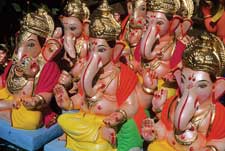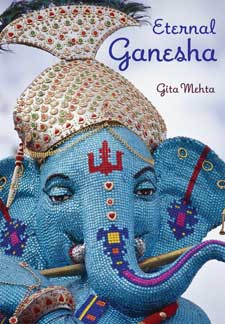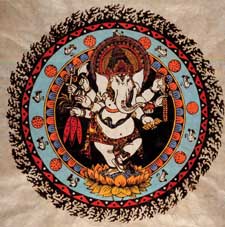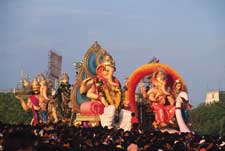Life
Ganesha: God of All Things

If He's for you, then who can be against you?
|
Just starting a new job, buying a new car or embarking on a new relationship? The surefire recipe for success is simple: first get Sri Ganesha’s blessings on the project. In fact, nothing in the Hindu world begins without appropriating the approval of Sanathana Dharma’s beloved elephant-headed God, the son of Shiva and Parvati.
Who doesn’t know Ganesha? His image is everywhere from temples to roadside dhabas, from the high art of classical miniature paintings to the low art of the bazaars. Ganesha is omnipresent from the sculptures in ancient 5,000 year old temples to guest appearances in Bollywood films like Don. At the recent Ganesh Chaturthi celebrations in Mumbai, Ganesha was even seen as muscle-bound ‘Krrish.’ He’s even starred in Terence McNally’s off-Broadway play, The Perfect Ganesh and is an integral player in Vikram Chandra’s acclaimed novel, Red Earth and Pouring Rain. American artist Heyoka Merrifield designs Ganeshas out of gold, silver, rubies and diamonds and his Ganesha shrine was in the collection of Beatle George Harrison. The actress Goldie Hawn is a big believer and Olivia Hussey has a whole collection of Ganeshas. The Hollywood screenwriter Tracey Jackson constantly wears a Ganesha around her neck. And President Clinton is known to keep a silver image of the Lord of Wisdom on his office desk in Harlem. Every luxury goods purveyor from Lalique to Baccarat to Daum and Lladro has jumped on the Ganesha trail, offering his images for thousands of dollars, which are being snapped up by the wealthy in India as well as in the Diaspora. Narender Agarwal of Ram Creations in Framington Hills, Mich., is a leading stockist of these upscale images and sells everything from Ganesha by Swarovski for $1,395 to one by Baccarat for $9,500 in a limited edition of 500 pieces. This must surely amuse Ganesha, who has seen himself created out of everything from green bananas to mud. Enterprising manufacturers in Shenzen, China, have capitalized on his popularity and are producing colorful images for the huge market in India and the Diaspora. Walk into Dipali, a store in New York, and you will find countless deities made in China by the Communists!
While Ganesha is often exoticised in the West, pictured on fashion clothing and bags and even having alcoholic drinks named after him, such as Tears of Ganesha at Tantra, a bar and lounge in Los Angeles, those who connect with Ganesha know and celebrate his true meaning and greatness. In Flushing, Queens, at Ganesh Pathshala, in honor of the Lord of Knowledge and the Arts, immigrant children gather to learn Bharat Natyam, Carnatic music and the veena, besides Hindi, Tamil, Telegu, advanced Math and English. He is on chains worn by women and children, sometimes tattooed on the arms of men, and ensconced in temples across America. There is hardly a Hindu Indian home without an image of Ganesh. He is everywhere from home shrines to décor items to kitschy fashion gewgaws. Even non-Hindus are fascinated by Him as a good luck icon, a benevolent presence. He is endearing because he is so accessible and non-judgmental. You have a few pounds to lose, so does Ganesha. You love sweets, so does Ganesha. You love the arts? So does Ganesha. You have a problem? Ganesha is happy to take it on for you. “For the Hindu, Ganesha is easily contacted, and He is thought of as lenient of our errors and shortcomings, most understanding of our humanness,” writes Satguru Sivaya Subramuniyaswami in the book Loving Ganesha. “So vast is Ganesha’s Being that He cannot be contained by any single concept, and therefore He is portrayed in many forms. He is each of them and He is all of them.” He adds, “As lord of obstacles Ganesha wields the noose and the goad, icons of the benevolent power of preventing or permitting events to happen in our life. Thus we invoke his grace and wisdom before any worship or task.” In fact, He is so powerful that according to the Upanishads, all other deities emanate from him. He is the only God with the power to banish obstacles. It seems this lesson was learnt the hard way by the mighty Lord Shiva who left to fight demons without first invoking the blessings of Ganesha, thinking He was, after all, only his son. Offended, Ganesha caused the axle of Lord Shiva’s chariot to break, stranding Shiva. The mighty god realized the error of his ways and immediately prayed to Ganesha, who then removed all obstacles from his path.
No wonder, no new undertaking begins without Ganesha. No Bollywood film will start production without blessing the cameras, breaking a coconut and invoking Ganesha. Hard-boiled multimillionaires wouldn’t dream of sealing a deal without first bowing to Ganesha and even the man who leases his phut-phutti or auto-rickshaw wouldn’t start his business day without folding his hands before the tiny photo of Ganesha propped against the steering wheel. Known as the God of New Beginnings and the Remover of Obstacles, Ganesha is central to the rituals of Hindu weddings. In fact, you’ll rarely find an invitation card that does not include an image of Ganesha, with the result that it becomes difficult to throw away these cards. Ganesha fans sometimes clip his image from the cards to serve as book markers. Appropriately so. After all, Ganesha is not only the Lord of Wisdom, but also the scribe who sacrificed his own tusk, breaking it off to use as a quill when transcribing the epic tale of Mahabharata from the sage Vyasa. Without him, this mighty tale and the Bhagvat Gita would not be written. Not surprisingly, he is beloved by Indian writers as a guard against writer’s block. Accessible and human as he seems to ordinary mortals, Sri Ganesha hreflects, Hinduism’s supreme power. “His four arms stand for His immense power in helping humanity. The noose and the goad borne in two of His hands stand for His all-pervasiveness and grace. The broken tusk held in the right hand shows that He is the hrefuge for all,” writes M. Arunachalam in Festivals of Tamil Nadu. “His huge belly is indicative of His tolerance and also signifies that all things, the entire Universe, are contained in Him. His feet stand for the bestowal of siddhi and buddhi, attainment of desires and knowledge. The modaka (sweet) in His hand is symbolic of jnana, conferring bliss. His mount, the shrew, represents the worldly desires, which are to be overcome.”
Ganesha is believed to be the Pitcher of Prosperity, the Granter of Boons and the Guarantor of Success and yet He is so much more. The noted writer Gita Mehta, author of Karma Cola and Snakes and Ladders, introduces people to this benign, chubby deity in Eternal Ganesha (Vendome Press), her new coffee table book about the God who is beloved the world over for his interactions with the affairs of humans. Ganesha has crisscrossed faiths in India to become the icon of protection, of good luck and prosperity. With his elephant head, his potbelly, his weakness for sweets and his preferred vehicle of a mouse, he is quite irresistible, but as Mehta points out, he’s much more than just a good luck emblem: “He is regarded as the Origin of the Universe, the Lord of Connection, of Cause and Effect, the Moment of Creation. He’s really a metaphor for a philosophical quest, an eternal search.” “What I love about Ganesha is that he symbolizes the greatness of Sanatana Dharma,” she adds. “The best thing that happens to you is that he forces you to explore yourself, the greatness within you. When you strip away everything else, our gods are accessible and there is a profound and beautiful logic as to why they exist and I try to show that.” And yet he’s such an intrinsic part of people’s daily lives – even a student’s struggle for good grades. She writes that Ganesha is the special god of India’s vast student population: Many students believe if they slice a closed text book with a Ganesha medallion the book will fall open at the very topic on which they will be examined! So how does one reconcile the elephant head with the human body? Says Mehta, “The comically corpulent body indicates the physical appearance is an illusion which must be overcome to reach truth. It is also symbolic of a divinity vast enough to contain the entire universe and all the contradictions that exist within it.” Indeed, Ganesh iconography is fascinating with deep meanings behind each of his attributes. He is a composite of four animals, with the head of an elephant, the body of a man, a snake binds his belly and he rides on a mouse. These contradictory animals – elephant and mouse, serpent and man – says Mehta, are contained within a single image, pointing to the supreme goal of Hindu metaphysics, finding an overarching unity in which all apparent contradictions can be contained.
“They also point to a moral imperative: that opposites can and must live in peaceful coexistence,” says Mehta. “Non-violence and humanism derive from that imperative. It is the union of the small with the great, the microcosm with the macrocosm. Illustrating the intimate connection between all life forms, as a meditational diagram, Ganesha incarnates Hindu philosophy’s fundamental law, the unity in diversity that it is humanity’s primary duty to maintain.” Gita’s lush, oversized book is laden with 125 color photographs, which show the fascinating array of Ganesha’s portrayal in India. He is shown with four arms, 12 arms, even 32 arms – and with three faces or even five faces – or sometimes as simply as a triangle of mud with a streak of vermilion at its apex, in some humble homes. Ganeshas have been fashioned out of green bananas, entirely out of peanuts, and in some cases matchsticks or discarded rubber tires. And at home, the images are often taking on a contemporary touch, with Ganesha sporting everything from a Gandhi cap to swinging a cricket bat. Ganesha Chaturthi is the festival celebrating the birth of this joyful god and is one of the most colorful national festivals of India. After rituals, chanting and prayers, thousands of clay images of Ganesha are taken in colorful processions in the streets before being immersed in the ocean in a rite called Visarjna. The festival is especially big in Maharashtra, but is now celebrated in many parts of the Indian Diaspora. In the evening as the sun sets on Hindu communities around the world, thousands of clay images of Ganesha are taken in procession with chanting, music and dancing to be immersed in the rivers, tributaries and oceans. Appropriately, the very first temple to be built in America was dedicated to Ganesha, who is after all, the Lord of New Beginnings. The Sri Maha Vallabha Ganapati Devasthanam in Flushing, New York is a magnificent temple constructed in the South Indian tradition. It is here that Ganesh Chaturthi was first celebrated in America in 1977 and says Uma Mysorekar, president of the Hindu Temple Society of North America which manages the of the temple, “When the clay dissolves in the water, the energy of Ganesha is spread all over, floating across the oceans to bless the entire universe.” In her book A New Religious America, Diana Eck, professor of Comparative Religion at Harvard University recounts how this festival has been celebrated also on the West Coast since 1991: “The Hindus from the San Francisco Bay area launched this tradition, carrying painted clay images of Ganesha to an artillery site in the old presidio that they converted into a temple and then broke coconuts at the feet of Ganesha and then immersed the images – all biodegradable – in San Francisco Bay. For the first time in history the mayor of San Francisco issued a proclamation declaring the date September 22, 1991, as Golden Gate Ganesha Visarjana Day.” When the diverse communities of Nashville were building a temple they had to choose a central deity; they voted amongst the many gods of the Hindu pantheon – and Ganesha won by a landslide.
In constructing hundreds of temples across the world from South Africa to Germany to Australia, immigrants have taken their biggest asset, the Remover of Obstacles, with them on their journeys. At many places, a Ganesha image was initially installed in an empty space; priests were brought from India, devotees flocked to the shrines, the worship began, and the funds to construct the temple began to flow. As Subramuniyaswami notes in Loving Ganesha: “This practice has now become a tradition in the West as Hindus have learned from experience that once Lord Ganesha is worshiped, it is actually He who builds the temples in a most wonderful and inspiring way, and they are his helpers.” Ganesha continues to fascinate people everywhere, including young Hindus who are growing up far from their homeland. The Hindu Cultural Society in Cambridge provides this succinct interpretation of Ganesha: “The whole cosmos is known to be the belly of Ganesha. Parvati is the primordial energy. The seven realms above, seven realms below and seven oceans, are inside the cosmic belly of Ganesha, held together by the cosmic energy (kundalini) symbolized as a huge snake which Ganesha ties around Him. The mouse is nothing but our ego. Ganesha, using the mouse as a vehicle, exemplifies the need to control our ego. One who has controlled the ego has Ganesha consciousness or God-consciousness.” Educating the younger generation on Hindu values and spirituality continues across continents and the Ganesha Temple in Queens, New York has a Ganesha Pathshala where young Indian Americans learn about their own religion, music and dance, and Hindu values. A beautiful story about Ganesha exemplifies just how he conquered the world. Shiva and Parvati once asked their two sons, Ganesha and Kartikeya to race around the world three times to see who should be the leader. While Kartikeya dashed off on his peacock mount, Ganesha was expected to make the journey on his slow-moving mouse. Showing wonderful logic and diplomacy, he won by simply circling around his divine parents three times, saying “You are the world.” Riding on his mouse, holding his axe and his goad and noose to catch bad karma, Sri Ganesha continues to engage believers and non-believers, holding out the sweet modaks of divine joy for a life well-lived.
|







You must be logged in to post a comment Login